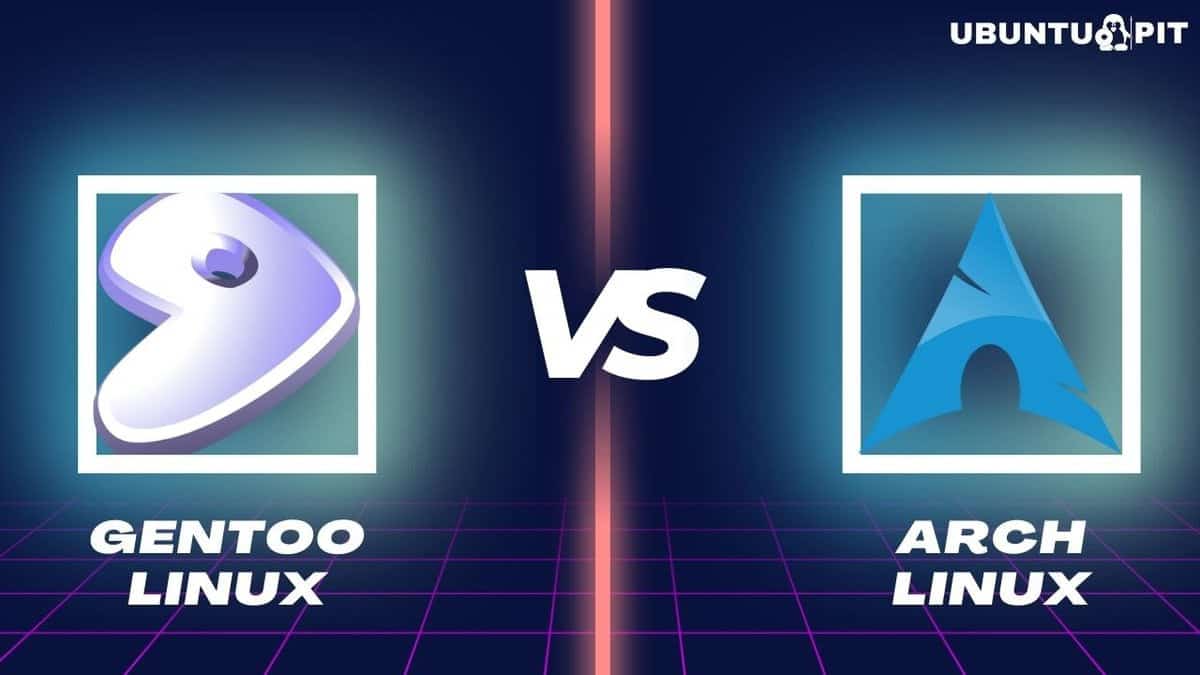Out in the wild, nearly a thousand Linux distributions are available, with 600 being actively maintained. Among them, two are well known for their performance, customization, and DIY approach. Yes, we’re talking about Gentoo Linux and Arch Linux! But which one is the best?
To answer that, we’ll go over every aspect of Gentoo vs. Arch Linux in this article. From the advantages and drawbacks they each offer to how they differ from each other and what they have in common. Let’s start!
What is Gentoo Linux?

Gentoo Linux, launched in 2000, is a highly customizable free and open-source system based on the Linux kernel. It’s a source-based distribution. That means every piece of software is compiled from its source code. This allows users to optimize their installation according to their specific hardware and preferences.
Now, this level of control is appreciated by many power users. However, it can be overwhelming for new Linux users.
Pros of Gentoo Linux
Let’s look at some benefits of using Gentoo Linux:
- Customizability – Gentoo is quite popular for its high customization. You can configure anything and everything, from its living heart–the Linux kernel, to compile-time options. This helps users to create a system that is truly their own.
- Efficiency – Gentoo Linux is quite efficient, too. Thanks to its “USE flag” system, you can have a barebone OS without any unnecessary features.
- Security – In Gentoo, you get to audit and patch the packages you compile, thanks to its source-based nature. Not to mention, all the available packages are thoroughly tested before release. Both of these add additional security.
Cons of Gentoo Linux
Now, it’s not all rainbow and sunshine with Gentoo Linux. It has its share of downsides, too, including:
- Steep Learning Curve – Gentoo is not suitable for you if you’re starting with Linux. You should know and understand how Linux works if you wish to use it. If not, you will need to put time and effort into learning about compiling software, configuring kernel options, and managing system libraries.
- Time-Consuming Updates – Since Gentoo packages are complied from the source, updating your system can be a real-time hogger, especially if you have older hardware. And you’ll often need to wait for the packages to compile before you can install updates.
- Resource Intensive – Compiling software from sources is quite resource-intensive. You will need a powerful processor, more memory, and disk space for this. But if you’re using an older or less powerful computer, using Gentoo can get pretty tiring because of this.
What is Arch Linux?

Released in 2002, Arch Linux is a general-purpose, open-source Linux OS for x86-64 systems. It’s popular among Linux fans for being lightweight and flexible. Also, Arch follows the KISS or “keep it simple, stupid” philosophy, keeping everything minimal and straightforward.
And unlike Gentoo Linux, Arch is binary-based, meaning you don’t have to go through the hassles of compiling the packages yourself. Also, the default installation of Arch Linux is intentionally kept minimal. This allows you to add only the packages you need.
Pros of Arch Linux
Here are a few pros of using Arch Linux:
- The Arch User Repository (AUR) – Alongside the Arch official repositories that have thousands of packages, Arch Users also get access to the Arch User Repository (AUR). This is a community-driven repository that includes a large collection of package descriptions (PKGBUILDs). You can use these to build packages with makepkg and get software that is not in the main repo.
- Faster Updates – As you don’t have to compile anything yourself, updating Arch Linux is a breeze. Just type Pacman -Syu in the terminal and press enter, and you’ll have the latest and greatest packages in no time.
- Simple Package Manager – Arch Linux has the Pacman package manager. It’s known for being simple and fast. Users can install, update, and manage software on their computers easily through it. It works by installing pre-made packages directly onto the system, so you really don’t have to think about compiling them.
Cons of Arch Linux
Arch Linux also has some drawbacks, such as:
- The Arch User Repository (AUR) – While it’s one of the main advantages of Arch Linux, it’s also one of its key weaknesses. Using AUR can make your system unstable and insecure if you aren’t careful. Remember, anybody can upload any type of package description, including malicious ones.
- Less Customizable – Arch is also well known for being a DIY Linux Distribution. But it’s not as hands-on as Gentoo or Linux from Scratch (LFS). So, if you really want to have control over every aspect of your system, Arch Linux may not be for you.
- Hard to install: While the installation process is not as complex as Gentoo, Arch isn’t easy to install either. It has a simple text-based installer, which makes it harder for newbies to install.
Gentoo vs. Arch Linux: Key Differences

Now, let’s go over Gentoo vs. Arch Linux and see what makes them different from each other.
1. Installation
Installing Gentoo Linux is nothing like installing other popular OSes. It’s a highly manual process, and you have to configure every aspect of your system. From getting the right installation medium and preparing the disks to downloading and extracting the Gentoo operating system environment and setting it up for installation, everything is very hands-on.
Now, Arch is also a DIY OS, and its installation is manual but not as involved as Gentoo Linux. It has a more guided installation and begins with booting into a live environment, where you can partition disks, connect to the internet, and install the base system.
During installation, Gentoo offers to compile your own kernel with only the features needed to run properly on your specific hardware. This means that you get a lightweight kernel that is made to meet your needs. On the other hand, Arch provides a vanilla Kernel, which can be modified, but not as much as Gentoo.
2. Ease of Use
Gentoo is far more technical to use than Arch. Everything from setting up the OS to using it is extremely manual. You have to be fairly knowledgeable about low-level aspects of Linux to use it. Arch, on the other hand, is relatively simpler to use.
Installing, updating, and removing packages is also easier on Arch than Gentoo. For easier use, both distros come with Desktop environments, but Arch Linux has more of them compared to Gentoo.
3. Performance
Gentoo is named after the fastest swimming penguin species, the Gentoo. That should give you a hint or two about its performance. As we mentioned before, Gentoo is a source-based OS that gives you the option to optimize even the kernel through the “USE flag” system. This means you get a superbly fast and efficient system that gets the best out of your hardware.
On the other hand, Arch Linux offers prebuilt packages that aren’t built for any specific hardware. So, some packages may not be finely tuned for your system. However, as you don’t have to compile packages from scratch, Arch is less resource-intensive than Gentoo when managing packages.
4. Customization
When it comes to customization, both of these distros are known to be remarkably flexible. With Gentoo, you get to create a system that is truly meant for you. You get to choose what to install and what not to install, how the kernel is configured, how the package manager functions, etc.
Arch Linux isn’t that much granular, but it does provide a lot of customizability. Arch only provides a minimal foundation and lets the users build on top of it according to their needs. However, the customization process is not as complex as Gentoo, making it easier for newbies to get into.
5. Stability
Gentoo can be stable as a rock only if built correctly. It can be as stable as you want, as its stability is affected immensely by your use of the “USE flag” and “compiler flags”. However, because of having such fine-grained control over your systems, mistakes or misconfigurations can potentially lead to instability.
Recommended Post: Debian vs. Arch Linux: Which is Better for You?
Like Gentoo, the stability of Arch Linux is based on how you configure the system. For instance, relying too much on the AUR for packages can make the system less stable. But as you don’t have to compile your own packages for general usage, Arch may be more stable for day-to-day use.
Additionally, Gentoo offers both a stable branch and a testing branch for software packages. In the stable software branch, the packages are thoroughly tested before being pushed to users. On the other hand, Arch doesn’t have such things. It only has official repos and the AUR. However, the packages in AUR have never been tested. So, bugs, malicious code, and broken updates can cause instability in Arch Linux.
6. System Initilaziation
Now, the system initialization process handles how your system boots up, starts all the needed services, and manages the processes. And the Gentoo vs. Arch Linux heats up on this topic as well. Gentoo defaults to the OpenRC init system, but it supports other init systems, such as runit, s6 + s6-rc, sysvinit, and systemd.
On the other hand, by default, Arch Linux uses a systemd init system, though it supports many more. But OpenRC is lighter than Systemd. But systemd is newer and used in big distros like Debian, Ubuntu, etc. Because of this, systemd work well with most new Linux software and make managing system services easier.
To configure OpenRC services, you have to edit the /etc/conf.d file, and for system-wide configuration, the /etc/rc.conf file. Systemd’s configuration files can be found at /etc/systemd.
7. Release Model
Both Gentoo and Arch Linux are rolling release Linux distros. This means you’ll get regular small updates instead of major “stable” version releases like Debian or Ubuntu. So, if you keep updating regularly, you’ll always have the newest version of your distribution.
However, Gentoo follows a rolling release-ish model. It provides two software branches, stable and testing. The packages in stable are tested thoroughly, and that’s why they roll a bit behind. On the flip side, updates on Arch are rolled out daily, and you get to taste the latest and greatest software as soon as they come out.
8. Package Availablity
When it comes to packages, both Gentoo and Arch Linux have tons of packages that you can install with ease. Gentoo has over 19,000 packages! And these packages come from Gentoo’s official ebuild repository, which contains ebuild files that tell the package manager how to build and install the packages.
But you are not limited only to these packages. Due to Gentoo’s source-based nature, nearly every package under the sun is theoretically available, as long as someone has written an ebuild for it. Also, some large packages, like Firefox and LibreOffice, can be downloaded in a ready-to-use binary format as well.
On the other hand, Arch only offers a handful of packages through its official repository, around 14,000 or so. However, the Arch User Repository (AUR) hosts over 85,000 PKGBUILD shell scripts that you can use to build and install the packages that are not available in the main repository.
9. Package Management
Managing packages on Gentoo is no easy task. You’ll have to use the Portage, a source-based package manager, to build, modify, install, and remove packages from your Gentoo file system. When installing a package, it fetches the source code and then builds locally on your computer.
You can customize the package extensively through compile-time options such as USE flags. However, this extensive customizability can be overwhelming for seasoned and new Linux users alike.
Alternatively, Arch Linux uses Pacman, a simple and fast binary-based package manager. Using it, you can install, update, or remove packages with simple yet quirky commands. And because it’s binary-based, you don’t need to build anything, which makes it less complex and simpler compared to Gentoo’s Portage.
10. Security
When it comes to security, the Gentoo Vs. Arch Linux debate becomes more intense. Gentoo’s Portage and USE flags let you build packages with only the functions you need. This, in turn, enhances the security of your system. Also, you can use the Hardened Gentoo project to boost security further.
Arch Linux is also security-focused. It has various features such as hardened malloc, BPF hardening, Linux Kernel Runtime Guard (LKRG), sandboxing applications, network firewall, and many more to boost your system’s security. However, both distros rely on their users to secure their systems.
11. Community and Support
Compared to Gentoo, Arch Linux has a larger community and an even larger user base. As a result, Arch Linux users have access to more resources, forums, and manuals than Gentoo Linux users have.
But if you ever find yourself in a bind, just remember Gentoo and Arch both provide strong community support, each with unique advantages and tools to help you out.
12. Documentation
Now, both distributions have extensive documentation. But the Arch Wiki has made a name for itself for being easy to understand. It covers a wide range of topics and provides just enough information to be useful without becoming overbearing.
But this doesn’t mean Gentoo lags behind in documentation. It also has an exhaustive wiki that goes over everything in minute detail. But for new users, this can be quite hairy because it’s pretty technical. Gentoo also provides the Gentoo Handbook, an all-encompassing installation guide.
13. Target Audience

When choosing between Gentoo and Arch Linux, first, you have to consider your preferences and how comfortable you are with tinkering your system. If you’re into deep system customization and enjoy building your system from the ground up, then Gentoo Linux can be a solid choice.
Arch Linux, on the other hand, is for people who want a more curated rolling-release OS that can still be highly customized. If you want a balance between control and convenience, with a strong community providing support, Arch Linux might be the right choice.
14. Scalability
Gentoo’s source-based software management approach and the reconfigurability of its portage tool make it a relatively well-suited system to be used on a range of hardware, from massive cluster servers to tiny embedded machines and virtual containers.
Not to mention, the Itanium, SPARC, Alpha, ARM, MIPS, HPPA, S/390, x86 (i486/i686), x86_64, PPC/PPC64, and SPARC architectures are all officially supported by Gentoo. On the other hand, Arch only supports x86_64 machines. This makes it quite limited compared to Gentoo.
Gentoo vs. Arch Linux: Similarities
Even with all these differences, Gentoo and Arch Linux also have some similarities. Let’s go over a few of them.
1. Linux Kernel
While their methodology and usage of the kernel are dramatically different, both Gentoo and Arch Linux use the Linux kernel.
2. Philosophy
While Arch Linux is known for being modern, simple, and user-centric, Gentoo is all about being systemically customizable. However, they share a philosophy in that they are both extremely customizable and emphasize the users’ choice.
3. Community Involvement
Both of these distros are community-driven and rely on the community for development and other resources like Wikis, forums, and handbooks.
4. Learning Opportunity
Installing Arch or Gentoo Linux is a great way to learn more about how Linux works. Both let you explore and understand the system better by getting your hands dirty with the setup process.
So, if you want to dive deep into the heart of Linux, use the Wiki and handbook to set up either of these distros. This way you’ll learn more than you ever could about Linux, Kernels, and what makes them tick.
Conclusion: Which Distribution is Right for You?
Well, you have come to the end of Gentoo vs Arch Linux. But which one is the best? You should answer this yourself as it is ultimately determined by your preferences and needs. Both distributions provide a great level of flexibility and control over system settings.
They also come loaded with advantages suited for specific users. So, before making a choice, carefully evaluate your requirements. Regardless of the choice, both Arch and Gentoo exemplify the spirit of open-source software and will help you customize your computing experience to match your exact needs.
